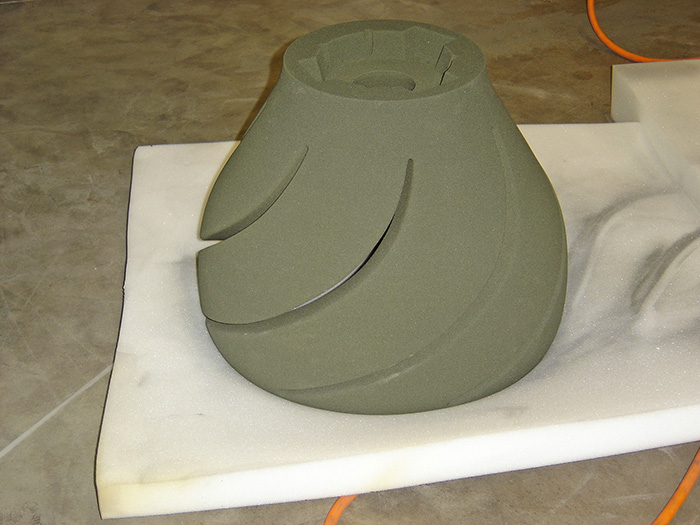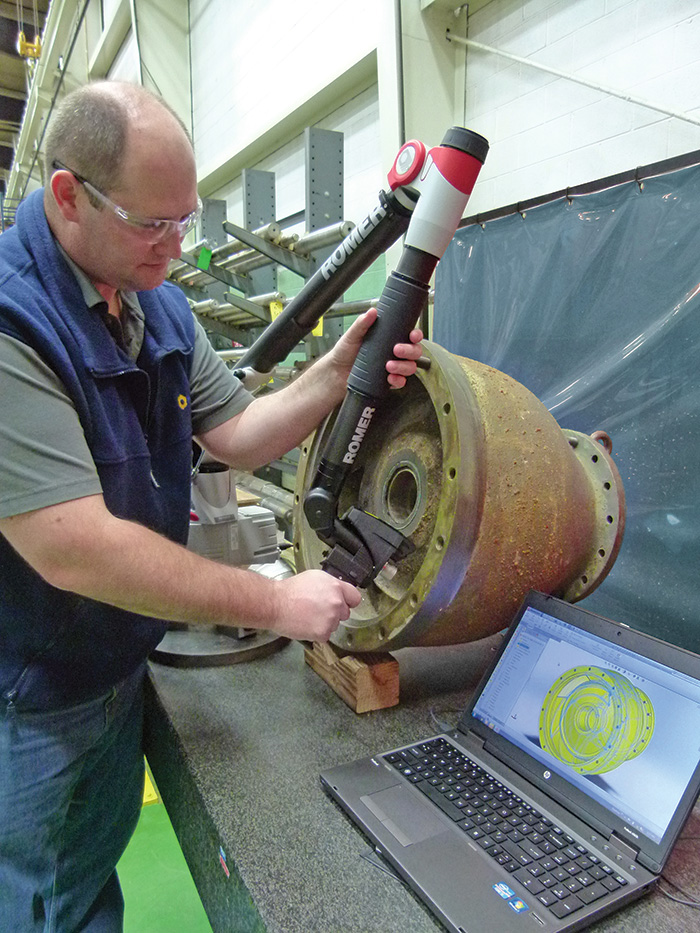Pumps & Systems, February 2013
During the last 20 years of my career, my main focus was the refining and chemical industries. As I approached retirement last year, I wrote “Pump Replacement Part Availability” (Pumps & Systems, February 2011), related to a problem facing those industries—the availability of replacement parts for pumps that are 40-plus years old. The U.S. already has an infrastructure problem that could get worse if it does not find ways to extend the lives of thousands of pumps.
Availability of parts is one solution.
After a brief retirement, I have found another role in the same capacity but more in the utility industry for fossil and nuclear power plants. I was not surprised to find the same problem—pumps are getting so old that parts are no longer available. If readers give this some thought, they might share my opinion—we have a nationwide problem that is not industry specific.
Image 1. Reverse engineering of a suction bowl
The Situation
I visited a utility company executive who confirmed that this is a large problem that will grow. To date, few initiatives address the problem. Most people say that when the pump ends its useful life, it will simply be replaced. This ignores the additional and often considerable capital cost involved in replacing the pump beyond the cost of the pump itself—such as motors, piping, foundations and service interruptions. The purpose of this article is to address this problem and answer a couple simple questions.
Who Is Responsible for Addressing the Problem?
While many will say that this is the fault of the original equipment manufacturer (OEM) and that OEMs should address it, that is simply not correct. The OEM originally sold the pump, noting a useful life of 20 to 25 years. Many pumps are decades older than that. The companies that originally bought the pumps have enjoyed service well beyond their original estimated useful life. One refinery recently rebuilt a pump that was 82 years old (“Upgrades Maximize Efficiency of 82-Year-Old Refinery Pump,” Pumps & Systems, August 2012). The owner should look back on the purchase of that pump as a real bargain. The current owners of these older pumps should accept responsibility for addressing this replacement part problem.
Who in a Company’s Organization Should Address This Situation?
A simple way to answer this is to eliminate the departments that are not responsible:
- Maintenance—Clearly, maintenance is not the place to put this problem. Maintenance is focused on one thing—keeping all the equipment working today. There typically is no long-term focus in the maintenance department.
- Reliability—This is another group with a clear focus to make things work longer and better and extend the mean time between repairs. This group has worked wonders in recent years to make things work longer, but it is not focused on keeping up with spare parts availability.
- Purchasing—While finding sources is part of the solution, the purchasing department is busy placing orders and expediting vendors to solve today’s problems.
The responsibility lies with the supply chain management. Many years ago, I had the good fortune of working in materials management. A key to that function was inventory control, and the obvious input to that function was lead time. The longer the lead time, the bigger the inventory control problem. With these old pumps, the lead time is infinite because their parts are no longer available. Supply chain management team members should address this problem.
Addressing the Issue
Each organization is free to assign the solution to this situation. However, addressing this problem requires taking a few key actions.
First, the problem and its significance should be evaluated. A newer plant may not have a problem. OEMs may be capable of fully supporting the pumps now and in the future. However, the older the plant, the more significant the problem. Refineries are probably in the worst shape with some power plants right behind them. Some of these plants are 75 to 100 years old. Having a pump in operation for 50 years is not unusual.
Second, the critical pumps and their age must be identified. No one can address all the pumps in a plant, so narrowing the problem is important. While the list may not be long, many times one pump out of service can be a disaster.
Third, answer the question: Does the OEM still support this model pump, and if so, for how much longer will it ensure a supply of spare parts? While we can hope that it has them all covered and in stock, we all know that it most likely does not. Focus on the pumps that are critical and that clearly no longer have OEM support.
Fourth, make the decision ahead of time. When this pump goes down, are we going to replace it or will we maintain its operation? If replacement is the chosen direction, that is fine. Get the engineering people planning and activate the capital plan to support this strategy. If the decision is to maintain operation of the existing pump, the remainder of this article includes some tips that might support this strategy.
Replacement Part Solutions
During the past several years, technology advancement in several areas has grown significantly and is being used to address problems, such as parts manufacturing. Two technologies that are useful in solving this parts problem are reverse engineering and additive manufacturing.
Reverse Engineering
Some people swear by reverse engineering and others swear at it, but it has become an accepted way to maintain the supply of spare parts. OEMs have embraced it, and many are aggressively developing their own reverse engineering capabilities. Advancements in user-friendly, coordinate-measuring machines are effective. Those same machines now offer scanning, which is a more powerful and accurate method of extracting shape information. Combine that with software advancements, and reverse engineering is now producing better results and doing it faster. These processes allow users to develop 3-D models of parts, which can then be machined or cast.
Additive Manufacturing
While most users are familiar with subtractive manufacturing (the process of starting with a piece of metal and removing chips to produce the shape you desire), additive manufacturing essentially starts with nothing and ends with the desired shape. While many materials are available using this process, the one that applies to this situation is sand. With sand, casting tooling (molds and cores) can be created. This allows users to eliminate the time delay involved in making hard toolings for castings. This computer-controlled process facilitates making castings faster and better than the traditional process.

Image 2. Vane core created via sand printing process
Lessons Learned
The solution that will work for solving these critical spares issues can best be summarized with these simple steps.
- Assign the responsibility.
- Develop the targets. Identify the parts before they are needed and none are available.
- Develop internal or external reverse engineering capabilities. Look for an opportunity to reverse engineer the parts. A routine maintenance job is a great time to do this.
- Use those capabilities to develop usable models. While the pump is down, identify and reverse engineer the key parts, especially the cast parts.
- Safely store them until needed. End users should make sure that they or a partnering supplier maintains a 3-D model of those parts. With these stored, someday (perhaps many years from now) that model can be recovered and used to make the critical part.
End users should become self-sufficient in this critical area to ensure pumping successful operations and minimize downtime.


